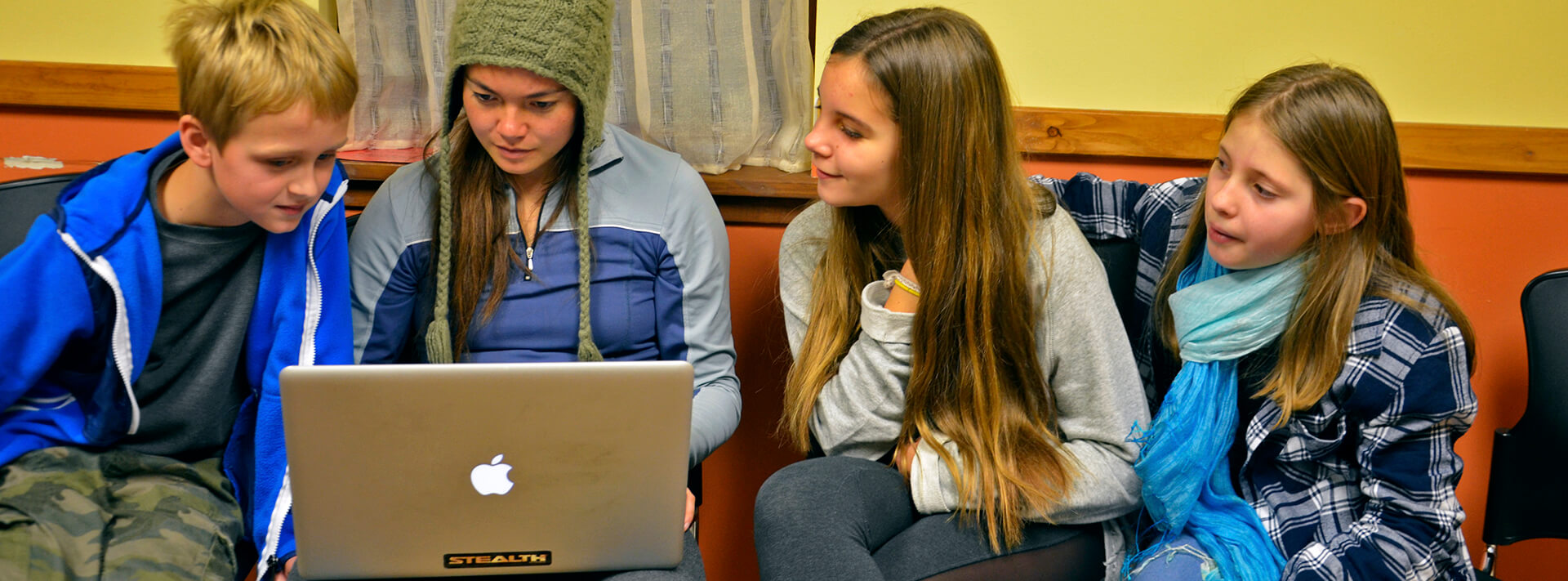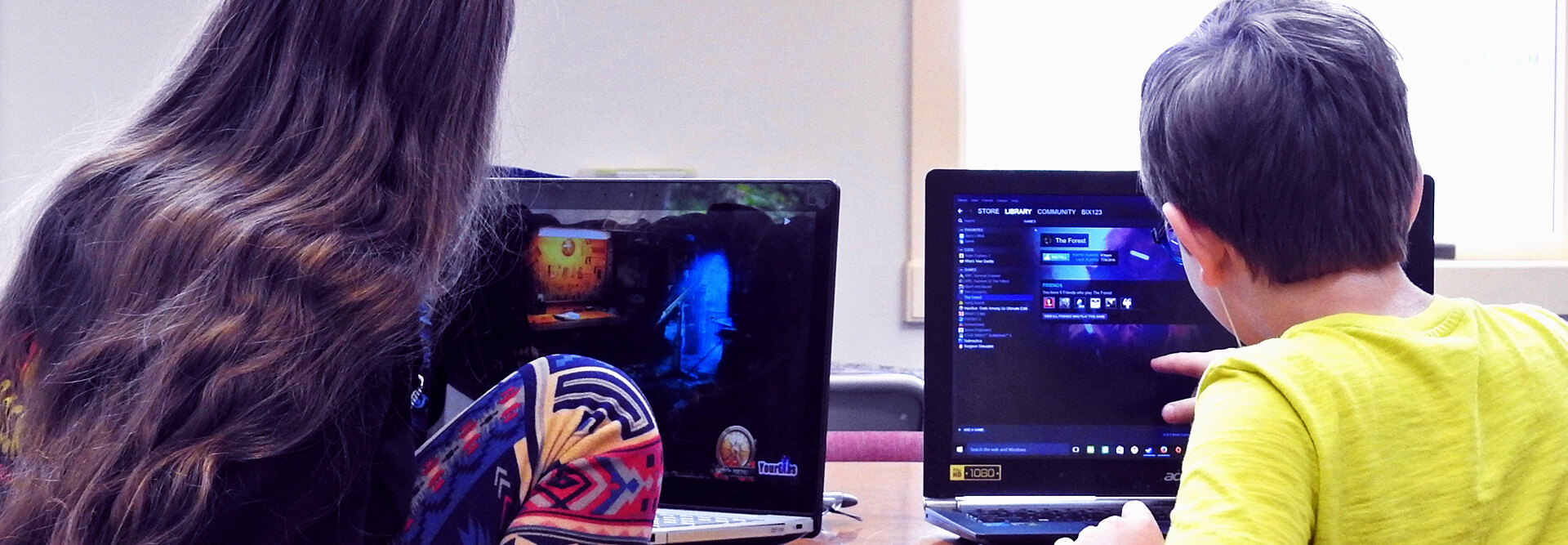There is an ongoing cultural debate about “screen time” and its effects on well-being. Most of the evidence is theoretical or anecdotal; there are no large-scale studies, meta-analyses, or longitudinal studies involving children and touchscreens. The debate is often confounded by the breadth of activity included in the term, “screen time.” This article won’t take a position on whether screen use is inherently good or bad, or on whether “over-use” even exists; instead, it describes how the Self-Directed Education (SDE) environments mitigate the potential of over-use and its associated suite of problems, while also creating a productive space for the “screen time” debate to unfold.
Screen Use in Self-Directed Education Spaces
As noted, in most SDE environments, there are no restrictions on how much students can use their screens. Upon receipt of this knowledge, some people assume the student body at a school like ours – the Hudson Valley Sudbury School – must be a zombie horde of proto-cyborgs: incontinent, drooling, and endlessly gazing into their glowing, jewel-like screens. But the truth is even more startling: screen use at our school is moderate.
It seems fair to suggest that insofar as people are turning towards their screens more and more, they may be attempting to meet basic psychological needs, such as the three proposed by Self-Determination Theory:
- Competence (seek to control the outcome and experience mastery),
- Relatedness (will to interact, be connected to, and experience caring for others), and
- Autonomy (desire to be causal agents of one’s own life).
Self-Directed Education environments create conditions which may satisfy these needs, thereby negating the need to “escape” into a screen. They do so in the following ways:
- They allow students to choose from a theoretically unlimited list of activities, as opposed to the strictly limited options available in conventional schooling environments. This condition increases the odds of each student finding something they might learn to master. Since students are free to move at their own pace, to experiment, and to work privately or with the company and instruction of others, they are less likely to be discouraged by failure and more likely to attain competence over a broad range of skills.
- They tend to feel more familial than institutional. “Screen time” is usually intensely social and offers lots of occasions for connection, both online and with friends at school. The freedom to choose companions, and to spend as much time as wanted with those companions, provides opportunities to develop deep and meaningful connections.
- If nothing else, SDE offers the chance to be the causal agent of one’s own life; full autonomy is central to the very definition of the concept of SDE.
One ability which is particularly relevant to screen over-use is self-regulation, which overlaps the first and third psychological need above. Self-regulation requires competence over a variety of skills, including lay-psychology, introspection, willpower, prioritization, and planning. SDE provides spaces for young people to begin mastering these skills – and in SDE environments they tend to do so in earnest, because they are responsible for themselves, and they know it.
Young people appreciate being trusted with the responsibility, just as adults take it for granted, and they feel that it’s right that they should be, and they rise to that occasion. It’s not that young people in SDE environments are self-disciplined ascetics – self-mastery is a lengthy and lofty project, just ask your local wisdom tradition – but they do tend to be “advanced” in this area, especially after a few years. If you ask around at our school, many teenagers will tell you things like, “I don’t use instagram at school; it’s not what I’m here for,” or, “I don’t bring my tablet to school so I can focus on my friendships.”
The bottom line is that “over-use” is less likely to occur at our school, and that when it does occur anyway, it is less likely to persist, and that when it does persist anyway, the environment is supportive of the phenomena running its course in a healthy manner.

Solving the (Potential) Problem
The focus of this section is the Sudbury model, and Hudson Valley School in particular, because that’s what I know first-hand, but much here will also be true for other SDE spaces. The Sudbury model provides a hopeful platform for working towards reasonable solutions to any problems posed by screen-use. By utilizing a democratic governance structure and – even more importantly – by building a “democratic ethos,” Sudbury facilitates productive communication.1
Recently, France passed a national law prohibiting public school students from bringing their phones to school in order to intercept what administrators and teachers saw as a slew of problems phones were causing in their schools. But prohibition has a poor track record; it’s riddled with psychological hazards, and it subverts the need for autonomy and debilitates communication by setting up an antagonistic dynamic between those with power and those without. Sudbury schools, by contrast, are direct democracies, and there is no authority separate from and above the student body. This simple yet astounding circumstance sets everyone at ease from the get-go. The ethos of the school is likewise democratic, in the best sense: staff and students regard each other as fundamentally equal, and the right to be and to express oneself is universally respected. There’s something like a vibrational field of equality which protects the school culture; it’s not that there aren’t differences among us, or that power is never abused; it’s that we respect each other’s autonomy. An equivalent ethos – and therefore arena for conversation – can be found in many other SDE spaces, including those which do not operate as direct democracies.
Taken together, our structure and ethos facilitate clear and honest communication; because there isn’t a power differential between any two parties – and the threat of patronizing regulation or prohibition is absent – real, vital conversations can unfurl. Students and staff alike relax and talk without fear of retaliation. It’s like your friend who’s a good listener and doesn’t judge you: you talk to them, and the conversations are enormously helpful in processing your experience and moving forward. Contrast this to conversations you have with that friend (or family member) who moralizes, jumps to conclusions, and gives unsolicited advice (usually along the lines of, “you should be more like me,”): you avoid talking to them, and when they do get their hooks into you, you resent them and their message; it’s counterproductive.
Many SDE spaces, including Sudbury Schools, have formal platforms for communication as well. At a recent meeting here at HVSS a group of teenagers actually brought up the issue of “screen overuse” in our wider society, and asked for discussion on how we might proactively address it at school. Prohibition theoretically possible, but impossible to imagine: if anyone formally proposed it, every School Meeting Member would show up with their pitchforks and torches, ready to defend their freedom. So the meeting was creative, and several promising ideas were proposed, including the creation of a “screen-free” zone in the building, a petition which willing parties could sign, agreeing to put their screens down during certain times, and the organization of more school-wide activities. Discussions like these usually don’t lead to the adoption of any new policy or law, but they do affect the school culture, and our culture is more important than our legal structure anyway, because it’s more influential on students’ experience at school.
The fact is screens are not going anywhere, and no doubt more are on the way. To the extent that their use may include hazards, the best safeguards against them are found in free and equal spaces such as those created by SDE: 1. The opportunity to live a rich life which satisfies our needs, and 2. A space to grapple with the issues in a supportive community of productive communication which sharpens minds, challenges assumptions, and lends courage. SDE environments are thus well positioned to navigate the the incoming tide of screens, as well as other approaching oceans.
[1] NB: This is what it does at its best. It’s important to acknowledge that good communication is not automatic; ultimately it relies on the good faith of the individuals involved.
If you enjoyed this article and feel called to give back to ASDE, here are ways you can support our work:
- Donate money
- Share our content with others! Click one of the buttons above to easily share on Twitter, Facebook, or email.
- Consider becoming a Contributor for Tipping Points
Tipping Points Magazine amplifies the diverse voices within the Self-Directed Education movement. The views expressed in our content belong solely to the author(s). The Alliance for Self-Directed Education disclaims responsibility for any interpretation or application of the information provided. Engage in dialogue by reaching out to the author(s) directly.






